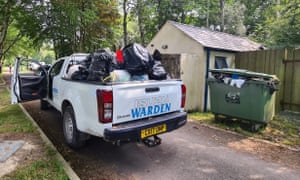For some years, Britain’s national parks have been wrestling with the same conundrum: how to attract a broader range of visitors.
This summer, they got what they all thought they wanted: the biggest influx of new visitors in their history. With foreign travel off the agenda for most and the shops closed, people who had never before walked up a hill, let alone worn Gore-Tex, heading to their nearest national park as soon as lockdown restrictions were eased.
“I was having a laugh with the chief executive of the Yorkshire Dales, and we were saying we’ve experienced this year what we always wished for, which is the target audience we’ve missed in the past,” says Emyr Williams, the chief executive of Snowdonia national park. “What we’ve had is a lot of problems.”
Some new visitors had unrealistic expectations, particularly around Snowdon, Wales’s highest mountain, says Williams: “People would drop us an email saying: ‘I’m coming on Saturday, please save me a parking space.'” Others would “go to Halfords, buy a tent for GBP40 and just leave it up the mountain, along with all their food and drink bottles”. Fly-camping, he calls it.
The new visitors tended to be younger, says Williams. “We attracted more of a crowd who would usually go to Spain on holidays, and it’s a different sort of culture that they have, shall I say.”
He remains dismayed that a minority thought it was OK to litter the beauty spots they had come to enjoy. “What is slightly ironic is that all young people now get a lot of environmental education, and they seem to be the worst,” he says. “My mother and father lived through the rationing period after the second world war, and that experience meant they never threw anything away.”
In the Peak District, rangers were soon dealing with three main problems: litter, fires and parking disputes. The first few months of lockdown were the quietest in the 69-year history of the UK’s oldest national park, particularly after Derbyshire police decided to use drones to shame people who had driven for half an hour from Sheffield to walk their dogs.
But when Boris Johnson eased restrictions in mid-May, the Peaks were inundated. Thanks to the good weather, “every day was like a bank holiday”, says Sarah Fowler, the park’s chief executive. The Monsal Trail, a traffic-free walking and cycling route near Bakewell, recorded double the number of visitors this summer compared with the same three months in 2019.

Considering that the national park is surrounded by the cities of Manchester, Sheffield and Derby, the normal visitor profile “is not as diverse as it could be, given who is on our doorstep”, admits Fowler. She was delighted that Covid brought a “a greater diversity of people enjoying the park”, in terms of race and class. In a survey, 25% of visitors said they had never been before.
Most people behaved impeccably, says Fowler. But still: “The litter was a bit of a shock to me. I couldn’t believe people were littering in the way they were. I was disappointed in the sense that people could just drop litter and walk away and not think about who is going to pick it up, or which bird might get stuck on it.”
In a normal year, the Peak District spends GBP38,000 picking up litter; this year Fowler expects to have shelled out double that. It’s a lot for an organisation covering an area of 555 sq miles (1437 sq km) which has a budget smaller than some secondary schools (GBP6.7m this year).
In the Cairngorms in the Scottish Highlands, most daft behaviour was just people not knowing the rules, says Grant Moir, the park chief executive: “I was out patrolling one night at Glenmore and there were a number of people who were starting fires or barbecues on the beach. We had a chat with them, and they put out their fires and one or two went to buy a wee stove from the shop nearby. Hopefully they’ll be back and camp in the park with their kids in the future and know more what they are doing next time. I don’t subscribe to ‘let’s all blame it on the townies’ – I think it’s a bit trite and a bit easy.”
Despite the influx of visitors, most people did not venture far from the “hotspots” such as Glenmore, Braemar and Loch Muick, says Moir: “The Cairngorms is 4,500 sq km. It’s absolutely ginormous, and even if you walk 500 metres from the hotspots, you will get away from the crowds pretty quickly.”
The dilemma for the park authorities is whether to encourage visitors to spread out or to stay in the same honeypots. In Snowdonia, Williams prefers the latter approach, continuing to funnel people towards Snowdon, climbed by 600,000 people annually, which not only has a train running to the top in normal times but also a cafe. He described Snowdon as more of an attraction than a mountain, and prefers to keep most people there, to leave the quieter areas of the park to “serious mountaineers and fell walkers”.
It’s cheaper and more sustainable to keep most people in the same place, says Williams: “If you were to dissipate 600,000 people around all the other massifs, the erosion would be quite substantial. So it’s more cost-effective to repair the footpaths on Snowdon, in terms of pence per person.”
But he insists he does not want the “Spain people” to get back on planes next year and never return to Snowdonia. “If they come here for scenery, culture, heritage, landscapes, exercise, great. If they are coming for a party, no.”